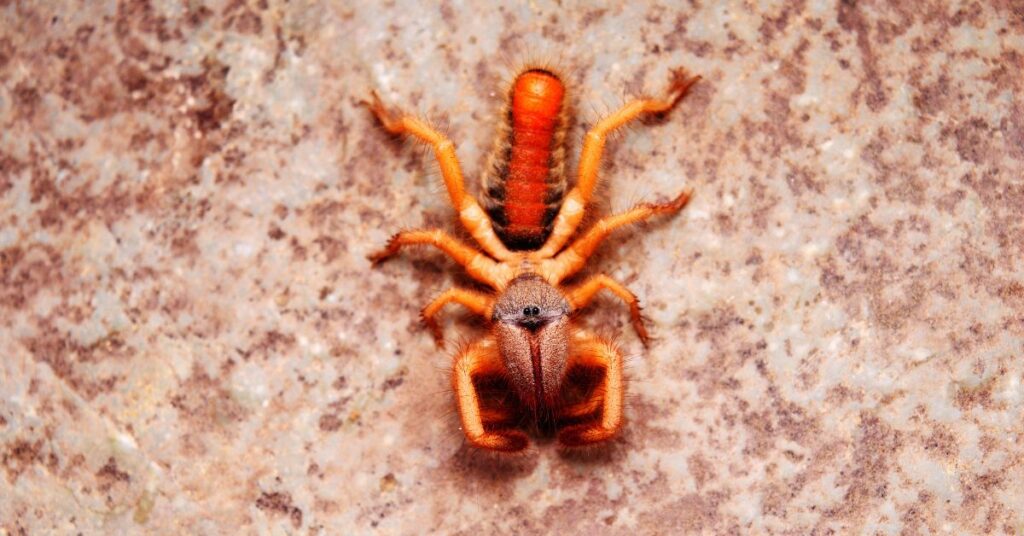
Sun spiders, also known as wind scorpions, camel spiders or solifuges, are a group of arachnids that are often mistaken for true spiders. Despite their name, these are not actually spiders and do not spin webs.
This article will explore the characteristics, behaviour, and ecology of sun spiders and answer some common questions about these fascinating creatures.
What is a Sun Spider?
Sun spiders are arachnids that are characterized by their long, spiny legs, large chelicerae (jaws), and absence of a web-spinning ability.
They range in size from small, coin-sized specimens to larger ones that can reach the length of a human hand.
These little beasties are found in many parts of the world, especially in hot, arid regions.
Their diet consists mainly of insects and other small arthropods, which they catch using their large jaws.

They are nocturnal hunters that are most active at night, when they search for prey.
The life cycle of a sun spider includes a series of molts, during which the spider sheds its old exoskeleton and grows a new one. We have an article on the molting process, here.
Sun spiders, also known as solpugids, are not true spiders but belong to the class Arachnida.
They have a distinct appearance, with long, thin legs and a round, segmented body.

They range in size from a few millimeters to three inches, with the larger species reaching 12–15 cm (5–6 in) in length, including legs.
Their color varies from yellowish-brown to reddish-brown, with some species sporting a lighter shade on their underbelly.
Why are they called Sun Spiders?
Their name refers to their habitation of hot dry regions and their typically golden colour as well as their preference for sunny habitats and their ability to tolerate high temperatures.
Distribution and Habitat
Sun spiders are found in warm and arid regions throughout the world, including North America, South Africa, and Australia. They typically inhabit deserts, scrublands, and grasslands, where they hunt for their prey and lay their eggs.
Diet
These animals are predatory insects, feeding mainly on insects and other small animals.
They use their sharp fangs to immobilize their prey, and then inject digestive fluids to break down the tissues.
They feed at night and hunt actively, using their speed and agility to capture their prey.
Life Cycle and Behaviour
Sun spiders go through three stages of life: egg, juvenile, and adult.
Female sun spiders lay their eggs in underground burrows, where they are protected from the harsh environmental conditions.
Juvenile sun spiders emerge from their eggs and undergo several molts before reaching adulthood.
As adults, sun spiders are active hunters, roaming their habitats in search of prey.
They are known for their aggressive behaviour and quick movements, making them formidable predators in their respective ecosystems, allowing them to quickly catch and subdue their prey.
They are capable of running at speeds of up to 10 body lengths per second, making them one of the fastest land animals in the world relative to their size.
What does a Sun Spider do?
Sun spiders play an important role in controlling the populations of insects and other small arthropods in their habitats.
By consuming large numbers of these pests, sun spiders help to maintain a balance in their ecosystem.
What are Sun Spiders Attracted to?
Sun spiders are attracted to areas with abundant prey, such as insect-rich habitats, and are often found near human settlements where insects are plentiful. They are also attracted to lights at night, which can attract insects and provide a source of prey.
How Poisonous are Sun Spiders?
Sun spiders are not venomous and do not pose a significant threat to humans. However, their large jaws can deliver a painful bite, so it is best to handle sun spiders with caution.
Can you Keep a Sun Spider as a Pet?
Sun spiders are not recommended as pets due to their large jaws and the difficulty of caring for them in captivity. Additionally, it is illegal to keep some species as pets in certain regions. However, it is possible. More can be read on that here.
Why is a Sun Spider not a True Spider?
Sun spiders are not true spiders because as already mentioned, they belong to a different order of arachnids known as Solifugae. Spiders belong to the order Araneae and have distinct physical and behavioural differences from sun spiders.
Can Sun Spiders Climb Walls?
Sun spiders have spiny legs and can climb rough surfaces such as rocks, but they are not able to climb smooth surfaces such as walls.
They are fascinating creatures that play an important role in controlling insect populations and maintaining balance in their ecosystems.
Despite their somewhat intimidating appearance, sun spiders are not venomous and generally do not pose a threat to humans.
However, it is still important to handle these creatures with caution and respect their natural habitats.
Understanding more about sun spiders can help us appreciate their role in the environment and the complex relationships that exist between different species in the natural world.
In summary, sun spiders are fascinating creatures that play an important role in their respective ecosystems as predators and prey.
Their unique physical characteristics and behaviour make them a fascinating subject of study for scientists and naturalists alike.
Now you’ve read all about the sun spider (which lets face it, isn’t pretty), why not take a look at one of our jumping spider articles, they’re far more cute and fluffy!
Until next time, stay spidery!
